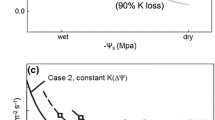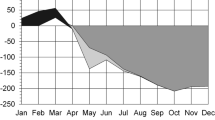Abstract
This study employed an intensive sampling regime in which leaf gas exchange and tissue-water relations were measured simultaneously on the same leaf at midday on 19 tree species from three distinct forest communities during wet (1990) and dry (1991) growing seasons. The study sites were located on a xeric barrens, a misic valley floor, and a wet-mesic floodplain in central Pennsylvania, United States. The xeric, mesic, and wetmesic sties had drought-related decreases in gravimetric soil moisture of 53, 34 and 27%, respectively. During the wet year, xeric and mesic communities had high seasonal mean photosynthetic rates (A) and stomatal conductance of water vapor (g wv) and low midday leaf water potential (ψ), whereas the wet-mesic community had low A and g wv and high midday ψ. The mesic and wet-mesic communities had dry year decreases in predawn ψ, g wv and A with the greatest drought effect occurring in the mesic community. Regression analysis indicated that species from each site that exhibited high wet-year A and g wv tended to have low midday ψ. This trend was reversed only in the mesic community in the drought year. Despite differences in midday ψ, all three communities had similar midday leaf turgor pressure (ψp) in the wet year attributable to lower osmotic potential at zero turgor (ψ 0π ) with increasing site droughtiness. Lower wet year ψ 0π in the xeric community was due to low symplast volume rather than high solute content. Species with the lowest ψ 0π in the wet year often did not have the lowest ψ 100π possibly related to differences in tissue elasticity. Moreover, increased elasticity during drought may have masked osmotic adjustment in ψ 100π but not in ψ 0π , via dilution of solutes at full hydration in some species. Despite the sampling regime used, there were no relationships between gas exchange and osmotic and elastic parameters that were consistently significant among communities or years. This result questions the universal, direct effect of osmotic and elastic adjustments in the maintenance of photosynthesis during drought. By including a large number of species, this study provided new insight to the ecophysiology of contrasting forest communities, and the community-wide impact of drought on contrasting sites.
Similar content being viewed by others
References
Abrams MD (1988) Sources of variation in osmotic potentials with special reference to North American tree species. For Sci 34:1030–1046
Abrams MD, Knapp AK (1986) Seasonal water relations of three gallery forest hardwood species in northeast Kansas. For Sci 32:687–696
Abrams MD, Kubiske ME, Steiner KC (1990a) Drought adaptations and responses in five genotypes of Fraxinus pennsylvanica Marsh.: photosynthesis, water relations and leaf morphology. Tree Physiol 6:305–315
Abrams MD, Schultz JC, Kleiner KW (1990b) Ecophysiological responses in mesic versus xeric hardwood species to an early-season drought in central Pennsylvania. For Sci 36: 970–981
Abrams MD, Kubiske ME, Mostoller SC (1993) Relating gas exchange and tissue-water relations to leaf structure in 17 species of contrasting temperate communities. Ecology 75:123–133
Bahari ZA, Pallardy SG, Parker WC (1985) Photosynthesis, water relations, and drought adaptation in six woody species of oakhickory forests in central Missouri. For Sci 31:557–569
Bazzaz FA (1979) The physiological ecology of plant succession. Annu Rev Ecol Syst 10:351–371
Bazzaz FA, Carlson RW (1982) Photosynthetic acclimation to variability in the light environment of early and late successional plants. Oecologia 54:313–316
Bowman WD, Roberts SW (1985) Seasonal and diurnal water relations adjustments in three evergreen chaparral shrubs. Ecology 66:738–742
Braker WL (1981) Soil survey of Centre County, Pennsylvania. USDA Soil Conserv Service, Washington, D.C.
Bunce JA (1977) Nonstomatal inhibition of photosynthesis at low water potentials in intact leaves of species from a variety of habitats. Plant Physiol 59:348–350
Caemmerer S von, Farquhar GD (1981) Some relationships between the biochemistry of photosynthesis and the gas exchange of leaves. Planta 153:376–387
Colombo SJ, Teng Y (1992) Seasonal variation in the tissue water relations of Picea glauca. Oecologia 92:410–415
Cutler JM, Rains DW, Loomis RS (1977) The importance of cell size in the water relations of plants. Physiol Plant 40:255–260
Davies WJ, Kozlowski TT (1977) Variations among woody plants in stomatal conductance and photosynthesis during and after drought. Plant Soil 46:435–444
Ellsworth DS, Reich PB (1992) Water relations and gas exchange of Acer saccharum seedlings in contrasting natural light and water regimes. Tree Physiol 10:1–20
Foster JR (1992) Photosynthesis and water relations of the floodplain tree, boxelder (Acer negundo L.). Tree Physiol 11:133–149
Hinckley TM, Dougherty JP, Lassoie JE, Roberts JE, Teskey RO (1979) A severe drought: impact on tree growth, phenology, net photosynthetic rate and water relations. Am Midl Nat 102:307–316
Hull JC, Wood SG (1984) Water relations of oak species on and adjacent to a Maryland serpentine soil. Am Midl Nat 112:224–233
Jurik TW, Weber JA, Gates DM (1988) Effects of temperature and light on photosynthesis of dominant species of a northern hardwood forest. Bot Gaz 149:203–208
Keever C (1973) Distribution of major forest species in southeastern Pennsylvania. Ecol Monogr 43:303–327
Kloeppel BD, Abrams MD, Kubiske ME (1993) Seasonal ecophysiology and leaf morphology of four successional Pennsylvania barrens species in open versus understory environments. Can J For Res 23:181–189
Kubiske ME, Abrams MD (1990) Pressure-volume relationships in non-rehydrated tissue at various water deficits. Plant Cell Environ 13:995–1000
Kubiske ME, Abrams MD (1991) Rehydration effects on pressure-volume relationships in four temperate woody species: variability with site, time of season and drought conditions. Oecologia 85:537–542
Kubiske ME, Abrams MD (1993) Stomatal and nonstomatal limitations of photosynthesis in 19 temperate tree species on contrasting sites during wet and dry years. Plant Cell Environ 16:1123–1129
Kwon KW, Pallardy SG (1989) Temporal changes in tissue water relations of seedlings of Quercus acutissima. Q. alba, and Q. stellata subjected to chronic water stress. Can J For Res 19:622–626
Ludlow MM (1987) Defining shoot water status in the most meaningful way to relate to physiological processes. In: Proc International conference on measurement of soil and plant water status: vol 2. Logan, Utah, pp 47–53
Neter J, Wasserman W, Kutner MH (1985) Applied linear statistical models. Irwin, Homewood, Illinois
Ni B-R, Pallardy SG (1991) Response of gas exchange to water stress in seedlings of woody angiosperms. Tree Physiol 8:1–9
Ni B-R, Pallardy SG (1992) Stomatal and nonstomatal limitations to net photosynthesis in seedlings of woody angiosperms. Plant Physiol 99:1502–1508
Nowacki GJ, Abrams MD (1992) Community, edaphic, and historical analysis of mixed oak forests of the Ridge and Valley Province in central Pennsylvania. Can J For Res 22:790–800
Osonubi O, Davies WJ (1980) The influence of plant water stress on stomatal control of gas exchange at different levels of atmospheric humidity. Oecologia 46:1–6
Parker WC, Pallardy SG (1985) Genotypic variation in tissue water relations of leaves and roots of black walnut (Juglans nigra) seedlings. Physiol Plant 64:105–110
Parker WC, Pallardy SG (1987) The influence of resaturation method and tissue type on pressure-volume analysis of Quercus alba L. seedlings. J Exp Bot 38:535–549
Parker WC, Pallardy SG, Hinckley TM, Teskey RO (1982) Seasonal changes in tissue water relations of three woody species of the Quercus-Carya forest type. Ecology 63:1259–1267
Ranney TG, Whitlow TH, Bassuk NL (1990) Response of five temperate deciduous tree species to water stress. Tree Physiol 6:439–448
Ranney TG, Bir RE, Skroch WA (1991) Comparative drought resistance among six species of birch (Betula): influence of mild water stress on water relations and leaf gas exchange. Tree Physiol 8:351–360
Reich PB, Ellsworth DS, Kloeppel BD, Fownes JH, Gower ST (1990) Vertical variation in canopy structure and CO2 exchange of oak-maple forests: influence of ozone, nitrogen, and other factors on simulated canopy carbon gain. Tree Physiol 7:329–345
SAS Institute (1985) SAS user's guide: statistics, version 5 ed. SAS Institute Inc., Cary
Saliendra NZ, Meinzer FC (1991) Symplast volume, turgor, stomatal conductance and growth in relation to osmotic and elastic adjustment in droughted sugarcane. J Exp Bot 42:1251–1259
Schulte PJ (1992) The units of currency for plant water status. Plant Cell Environ 15:7–10
Turner NC, Jones MM (1980) Turgor maintenance by osmotic adjustment: a review and evaluation. In: Turner NC, Kramer PJ (eds) Adaptations of plants to water and high temperature stress. Wiley, New York, pp 87–103
Tyree MT, Jarvis PG (1982) Water in tissues and cells. In: Lang OL, Nobel PS, Osmond CB, Ziegler H (eds) Physiological plant ecology II (Encyclopedia of plant physiology, NS, vol 12B). Springer, Berlin Heidelberg New York, pp 36–77
Tyree MT, Cheung YNS, MacGregor ME, Talbot AJB (1978) The characteristics of seasonal and ontogenetic changes in the tissue—water relations of Acer, Populus, Tsuga, and Picea. Can J Bot 56:635–647
Wilson JR, Ludlow MM, Fisher MJ, Schulze E-D (1980) Adaptation to water stress of the leaf water relations of four tropical forage species. Aust J Plant Physiol 7:207–220
Wuenscher JE, Kozlowski TT (1971) Relationship of gas-exchange resistance to tree-seedling ecology. Ecology 52:1016–1023
Yoon TM, Richter H (1990) Seasonal changes in stomatal responses of sweet cherry and plum to water status in detached leaves. Physiol Plant 80:520–526
Author information
Authors and Affiliations
Rights and permissions
About this article
Cite this article
Kubiske, M.E., Abrams, M.D. Ecophysiological analysis of woody species in contrasting temperate communities during wet and dry years. Oecologia 98, 303–312 (1994). https://doi.org/10.1007/BF00324218
Received:
Accepted:
Issue Date:
DOI: https://doi.org/10.1007/BF00324218




